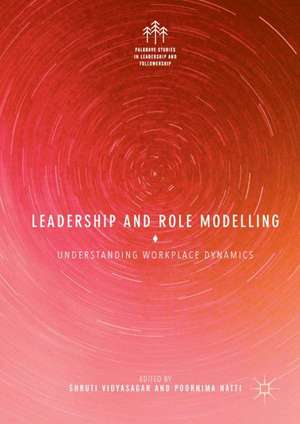Leadership and Role Modelling: Understanding Workplace Dynamics: Palgrave Studies in Leadership and Followership
Editat de Shruti Vidyasagar, Poornima Hattien Limba Engleză Hardback – 5 mar 2018
| Toate formatele și edițiile | Preț | Express |
|---|---|---|
| Paperback (1) | 631.30 lei 6-8 săpt. | |
| Springer International Publishing – 25 dec 2018 | 631.30 lei 6-8 săpt. | |
| Hardback (1) | 884.29 lei 6-8 săpt. | |
| Springer International Publishing – 5 mar 2018 | 884.29 lei 6-8 săpt. |
Preț: 884.29 lei
Preț vechi: 1078.40 lei
-18% Nou
Puncte Express: 1326
Preț estimativ în valută:
169.36€ • 174.49$ • 141.87£
169.36€ • 174.49$ • 141.87£
Carte tipărită la comandă
Livrare economică 22 februarie-08 martie
Preluare comenzi: 021 569.72.76
Specificații
ISBN-13: 9783319690551
ISBN-10: 3319690558
Pagini: 200
Ilustrații: XXXIX, 200 p. 3 illus.
Dimensiuni: 148 x 210 mm
Greutate: 0.44 kg
Ediția:1st ed. 2018
Editura: Springer International Publishing
Colecția Palgrave Macmillan
Seria Palgrave Studies in Leadership and Followership
Locul publicării:Cham, Switzerland
ISBN-10: 3319690558
Pagini: 200
Ilustrații: XXXIX, 200 p. 3 illus.
Dimensiuni: 148 x 210 mm
Greutate: 0.44 kg
Ediția:1st ed. 2018
Editura: Springer International Publishing
Colecția Palgrave Macmillan
Seria Palgrave Studies in Leadership and Followership
Locul publicării:Cham, Switzerland
Cuprins
Section I. Dynamics of Workplace Role Modelling.- Chapter 1. A Followership Perspective on Role Modelling and Mentorship; Cassandra A. Ray and Michelle T. Violanti.- Chapter 2. Role Modelling and Its Impact on the Self-development of Academics; Julie Nyanjom.- Chapter 3. Role Modelling as an Alternative to Mentoring for Career Development Outcomes in Organisations; Tanjia M. Coleman.- Section II. Gender and Role Modelling.- Chapter 4. Close and Distant Female Role Models in the Workplace; Alexandra Lyman and Stacie F. Chappell.- Chapter 5. Complexities in the Role Model Identification Process for Educated Women from Rural India; Annu Mathew.- Section III. Practitioners' Perspectives.- Chapter 6. Role Modelling as a Means of Transformative Growth; Kshitij Sharma.- Chapter 7. Fostering Vision, Culture, and Accountability in Young Organisations through Role Modelling; Timothy Franklyn.- Chapter 8. Being and Following Role Models; Raju Ramachandran, T. S. Sridhar and Sudarshan Iyengar.
Notă biografică
Shruti Vidyasagar is a lawyer and editor. She has pursued a varied legal practice in Bengaluru, India, for several years, and works as a freelance editor for a number of leading academic presses. Shruti consults with DAKSH Society, a Bengaluru-based organisation working on responsibility in politics, governance and the judiciary. One of her recent publications appears in Unveiling Women’s Leadership (Palgrave, 2015).
Poornima Hatti heads the dispute resolution team at Samvad Partners, and is based in Bengaluru. Her primary area of focus is commercial and corporate dispute resolution law as well as employment law. She co-authored ‘Is Sexual Harassment at the Workplace Curtailing Women’s Growth?’ in Unveiling Women’s Leadership (Palgrave, 2015).
Poornima Hatti heads the dispute resolution team at Samvad Partners, and is based in Bengaluru. Her primary area of focus is commercial and corporate dispute resolution law as well as employment law. She co-authored ‘Is Sexual Harassment at the Workplace Curtailing Women’s Growth?’ in Unveiling Women’s Leadership (Palgrave, 2015).
Textul de pe ultima copertă
‘Understanding the dynamics of role modelling is an essential part of fostering a developmental culture at work or school. This book is packed with important information and insights based on cases and examples from various professional and cultural contexts, especially for those who want to make their places of work or study an enriching environment that affords positive transformative experiences.’
—Aarti Ramaswami, Academic Director and Associate Professor of Management, ESSEC Business School Asia-Pacific, Singapore
This edited volume explores the influence of role modelling as a process in the workplace; in particular, whether it can aid career development, offer psycho-social support, and provide the motivation and means to achieve goals. Chapters examine whether the dynamics of personal identification and self-belief can affect the way that role models are chosen, placing emphasis on geographical diversity and cultural aspects. By includingstudies of gender and followership in both American and Indian settings, the scholars and practitioners who contribute to this collection outline key aspects of role modelling, and its effect as a developmental tool in the workplace, from the perspective of the individual and organisations. This book is a valuable resource for academics interested in organisations, management, and diversity, as well as practitioners and policy-makers involved in leadership programmes, who will find its collection of both theoretical and empirical findings extremely useful.
—Aarti Ramaswami, Academic Director and Associate Professor of Management, ESSEC Business School Asia-Pacific, Singapore
This edited volume explores the influence of role modelling as a process in the workplace; in particular, whether it can aid career development, offer psycho-social support, and provide the motivation and means to achieve goals. Chapters examine whether the dynamics of personal identification and self-belief can affect the way that role models are chosen, placing emphasis on geographical diversity and cultural aspects. By includingstudies of gender and followership in both American and Indian settings, the scholars and practitioners who contribute to this collection outline key aspects of role modelling, and its effect as a developmental tool in the workplace, from the perspective of the individual and organisations. This book is a valuable resource for academics interested in organisations, management, and diversity, as well as practitioners and policy-makers involved in leadership programmes, who will find its collection of both theoretical and empirical findings extremely useful.
Caracteristici
Examines the conflict between role modelling and mentorship programmes in an organisational setting Describes the theoretical underpinnings of role modelling as a concept Examines whether gender influences the dynamics of workplace role modelling in different industries




